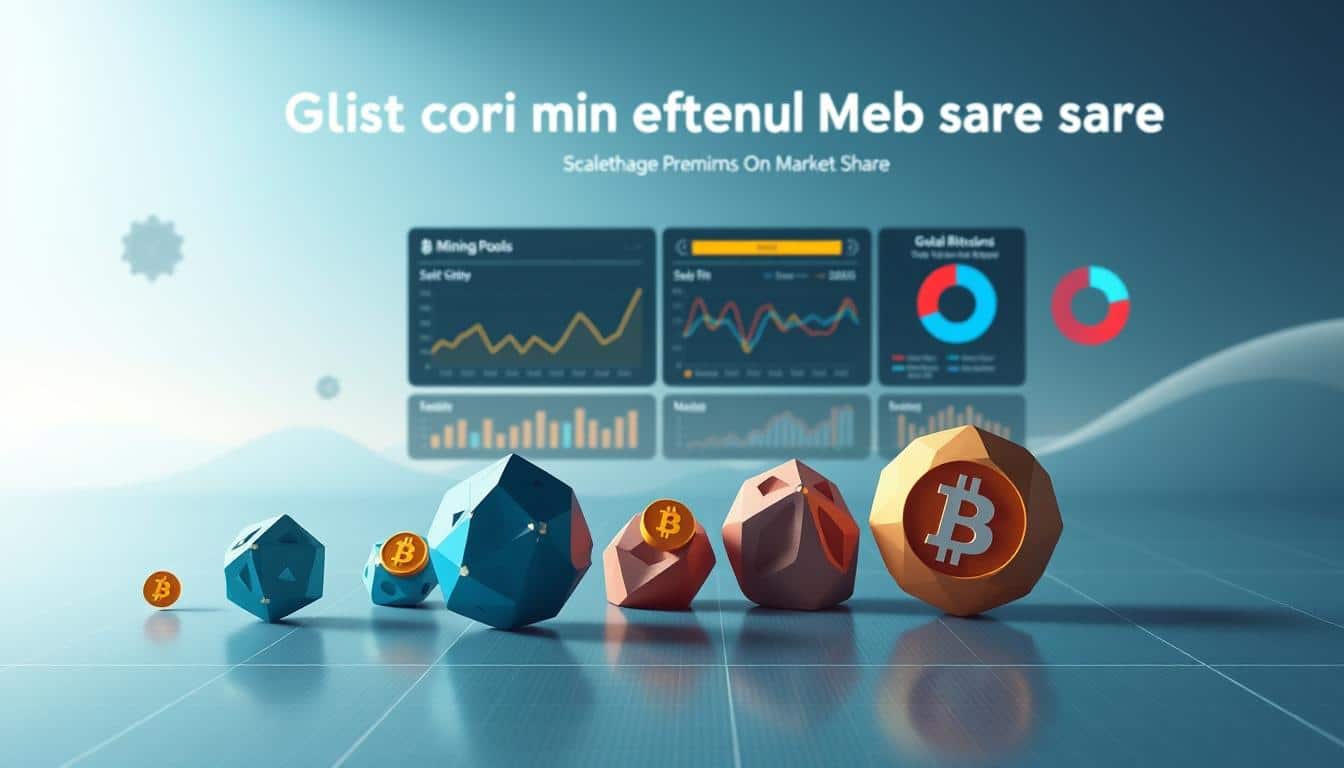Surprising fact: the five largest groups control roughly 80% of hash share, with Foundry USA alone near 30%.
I’ve tracked these numbers firsthand, and that concentration changes how small operators earn rewards. If you want steadier yields instead of wild variance, combining your hash with others makes block finds more regular.
In this guide I lay out what truly affects payouts: fees, payout schemes (PPS, PPLNS, FPPS), and pool reliability. Expect data, examples from major bitcoin mining pools, and a clear graph concept so you can see market share at a glance.
I’ll walk you through account setup on a pool website, adding stratum details, and choosing payout thresholds. Along the way I share dashboards and tools that turn power into predictable profits.
Key Takeaways
- Large operators dominate, so pick a pool with transparency and fair fees.
- Know payout schemes—FPPS boosts fee shares; PPLNS favors consistent contributors.
- Use dashboards to monitor hash, power use, and expected payouts.
- Set realistic profit expectations based on pool share and transaction fee trends.
- Follow sources and stats I cite to verify numbers and adjust settings.
Why join bitcoin mining pool now matters for consistent payouts and lower variance
Small operators see steadier income when they pool hash with others — fewer dry spells, clearer cash flow.
I switched my rigs into larger pools and the difference was immediate. Big operators like Foundry USA (~30% of blocks) and Antpool (~23%) find blocks more often. That frequency smooths out payouts for every contributing miner.
Variance is the enemy for hobby miners. Solo runs can leave you waiting weeks for a single reward. In a shared setup, your contributed hash is tracked and converted into proportional rewards more regularly.
Yes, fees exist. But lower variance often outweighs those costs, especially when electric bills and maintenance need steady cash flow.
| Pool | Approx. share of blocks | Effect on payouts |
|---|---|---|
| Foundry USA | ~30% | Very frequent blocks; smooth, predictable payouts |
| Antpool | ~23% | High cadence; lower day-to-day noise |
| F2Pool | ~10% | Good balance of frequency and decentralization |
| ViaBTC | ~9% | Consistent finds; transparent accounting |
- Stability: pooled hash reduces long dry runs and evens out payout timing.
- Transparency: reputable pools report contributed hash and rounds clearly.
- Practical tip: choose a larger pool with low interruptions and clear fees for steadier rewards.
Step-by-step guide: How to join a Bitcoin mining pool today
Before your rig submits its first share, follow a short setup routine that ties hardware, software, and account settings together. I prefer a checklist approach—keeps things tidy and reduces avoidable downtime.
Prepare essentials: ASIC hardware, mining software, and a Bitcoin wallet
Grab the essentials: an ASIC (Antminer or Whatsminer), a secure Bitcoin wallet address, and mining software your chosen pool supports.
Tip: verify firmware and network access before you move a miner into production.
Create a pool account and add stratum details for your miners
Create an account on the pool’s official website, enable 2FA, and add at least one payout address. Then copy the pool’s stratum URL into your miner and set a worker name.
- Point the miner to the pool’s stratum URL(s) and port.
- Confirm the pool shows your hash rate—workers should appear within minutes.
- If config fails, try backup stratum endpoints listed on the website.
Start mining, monitor your dashboard, and set a payout threshold
Start mining and watch the dashboard. Hash power ramps; shares submitted should rise steadily under “workers.”
Set a sensible payout threshold to balance transaction fees with cash flow. I start low to validate and raise it once the flow is consistent.
| Step | Action | Why it matters |
|---|---|---|
| Essentials | ASIC, software, wallet | Requires your own hardware; no free payouts without work |
| Account | Create on official website, enable 2FA | Protects funds and keeps payout addresses correct |
| Configure | Set stratum URL, worker name | Links your miner to the pool and measures share contribution |
| Monitor | Watch dashboard, track payouts | Ensures expected share of rewards and stable power use |
- Keep fans clean and firmware current—one failed unit can hurt uptime.
- Track payout history to confirm rewards match your share of work.
- Beware sites that promise payouts without hardware — red flag.
Follow these steps and you’ll be set to participate in a bitcoin mining pool with clearer expectations and fewer surprises.
Payout schemes explained: PPS, PPLNS, and FPPS and how they impact your earnings
How a pool pays you can make the same hardware feel like a different business. Understanding the three main schemes helps you match risk tolerance to expected returns.
PPS (Pay Per Share)
PPS pays per share you submit, regardless of block luck. That gives steady, predictable rewards, but expect higher fees for that certainty.
This is great when you need stable cash flow or have tight electricity margins.
PPLNS (Pay Per Last N Shares)
PPLNS ties payouts to the pay per last shares window. Earnings swing with pool luck; long-run returns can be higher but variance rises.
Hopping between providers often cuts your slice. If you plan to stay put and tolerate volatility, PPLNS can beat PPS over time.
FPPS (Full Pay Per Share)
FPPS looks like PPS but adds transaction fees to rewards. When on-chain transaction fees spike, FPPS can outperform basic PPS.
Foundry, F2Pool, and ViaBTC offer FPPS or PPS+/FPPS options. Antpool supports both PPLNS and PPS choices.
- Decision guide: pick PPS or FPPS for steady payouts; choose PPLNS if you accept variance and will remain stable.
- Practical tip: compare fee tables and run short tests—one week per scheme—to see what fits your setup.
Largest Bitcoin mining pools and what to expect in fees, rewards, and tools
A quick look at top operators shows how fee structure and uptime shape real-world rewards.
Snapshot: Foundry USA controls roughly 30% of blocks and runs an FPPS model with ~2% fees. Antpool follows near 23% and offers PPLNS and PPS with tiered fees (1.5–4%).
F2Pool sits around 10% with PPS+ (~2.5%), ViaBTC near 9% with PPS+/FPPS and fees up to 4%. Binance is ~8% (FPPS, ~4%), Luxor ~3% (2–3%), and Braiins ~1–2% with score-based distribution (0–2%).
Comparison highlights
- FPPS vs PPS+ vs PPLNS: FPPS adds transaction fee share; PPS+ stabilizes payouts but charges a premium; PPLNS rewards long-term contributors and raises variance.
- Typical fees and uptime: expect 1.5–4% ranges; choose pools with multi-region stratums and SLAs to avoid wasted power during outages.
- Tools matter: enterprise dashboards, API access, and quick redirection let miners move hash within minutes when performance or fees change.
| Provider | Approx. Share | Pay Model | Fee Range |
|---|---|---|---|
| Foundry USA | ~30% | FPPS | ~2% |
| Antpool | ~23% | PPLNS / PPS | 1.5–4% |
| F2Pool | ~10% | PPS+ | ~2.5% |
| ViaBTC | ~9% | FPPS / PPS+ | Up to 4% |
| Luxor | ~3% | FPPS / PPS | 2–3% |
| Braiins | ~1–2% | Score / PPLNS-like | 0–2% |
Tools and configuration: Software, stratum settings, and dashboards that make mining easier
Getting software and endpoints right is the fast path from setup to steady payouts.
I start by downloading the pool-supported software and logging into the website to set a payout address. Do this before you point a miner at a stratum; some operators hold balance until the address is verified.
Quick config example: Pointing your ASIC and verifying work
In the ASIC web UI add the primary and backup stratum URLs, a worker name, and a strong password if required. Point to the nearest regional endpoint to cut stale shares and latency.
- Three stratums: primary, secondary, tertiary—switches keep work flowing during outages.
- Firmware: use pool-recommended settings first; tweak frequency or voltage only after baseline tests.
- Network: enable QoS for miner traffic if your router supports it to reduce spikes.
Monitor hashrate, share acceptance, and rejected percentage on the dashboard. Set alerts (email or webhook) so you can act before payouts drift. Document config templates to clone settings when adding new hardware.
| Task | Action | Why it matters |
|---|---|---|
| Account setup | Set payout address, enable 2FA | Ensures payouts release and secures funds |
| ASIC config | Add stratums, worker name, password | Links your miner to the correct endpoint and records work |
| Monitoring | Track hashrate, shares, rejects, alerts | Detects network or hardware issues early |
| Templates | Save configs for rapid deployments | Saves time and reduces setup errors |
- Start software, verify workers appear on the website dashboard.
- Run for 24–72 hours, compare estimated share to actual payouts.
- Open support ticket for big gaps; small drift is normal.
Evidence and statistics: Hash rate concentration, pool market share, and fee realities
The numbers show a tight cluster of hash across a few providers, and that has real implications for rewards timing.
Graph concept: picture a pie chart with Foundry (~30%) as the largest slice, Antpool (~23%), F2Pool (~10%), ViaBTC (~9%), Binance (~8%), Luxor (~3%), Braiins (~1.24%) and an “Others” wedge. That visual explains why some operators find blocks more often and smooth payouts for contributors.
By-country concentration
A bar chart by headquarters shows China (~47%) and the United States (~34%) leading, followed by Malta (~8%), Czech Republic (~2%), and Japan (~2%).
“Centralization risk is real; a few large operators can affect network dynamics and payout variance.”
- Fee reality: every legitimate pool charges fees; fee structure interacts with PPS/FPPS/PPLNS to shape net returns.
- Because miners can redirect hash quickly, market share is fluid — watch weekly trends before committing.
- Pools with deep stratums and low stale-share rates preserve more of your effective earnings.
| Metric | Value | Why it matters |
|---|---|---|
| Top shares | Foundry 30%, Antpool 23% | More frequent block finds; steadier rewards |
| Country HQ | China 47%, US 34% | Operational risk and regulation exposure |
| Block reward | 3.125 BTC | Transaction fees can boost FPPS returns |
Use these stats as a compass, not dogma. Geography, latency, and uptime can make a smaller provider outperform on your setup.
Profit potential in the present: Fees, transaction fees, and hardware efficiency
Net returns hinge on small margins — and those margins live in fees, power, and uptime.
I expect 2025 to reward efficient setups. With good hardware and low pool fees, operations in low-cost power markets still find profits. In higher utility areas, margins get thin fast.
Prediction through 2025
Short version: FPPS lifts earnings when transaction fees spike; PPS gives steadier cash flow; PPLNS can win long term if you stay consistent.
| Scheme | Behavior | When it helps |
|---|---|---|
| PPS | Steady payouts | Stable cash flow |
| PPLNS | Variable, higher long-run upside | Consistent contributors |
| Full pay per (FPPS) | Adds transaction fees to rewards | High-fee periods |
Levers to improve earnings
- Power: cents per kWh is the biggest driver of profits. Negotiate rates or relocate gear.
- Pool selection: watch latency, rejected shares, and uptime—these quietly reduce earnings.
- Hardware: tune firmware, cooling, and voltages to boost efficiency without sacrificing reliability.
- Track daily results vs modeled estimates; switch scheme or provider for a short trial if variance persists.
Tools I use: a simple spreadsheet that combines kWh, fees, and estimated mining rewards to decide where to point hash.
Risk management: Avoiding scams, understanding centralization, and staying flexible
Scams and centralization are the two fastest ways to turn steady work into lost rewards. I’ve seen offers that promise free payouts — they rarely deliver. Real mining requires hardware and verifiable work.
- Promises of guaranteed free pay or fixed returns without hash evidence.
- Cloud contracts you cannot audit or redirect.
- Opaque fee schedules or vague payout terms.
Mitigations and practical steps
Prefer pools with transparent dashboards and on-chain payout records. Keep multiple configs ready so you can redirect hash within minutes if service degrades.
| Red flag | Risk | Mitigation |
|---|---|---|
| Free payouts | Lost earnings | Reject offers without proof |
| Opaque fees | Hidden cuts | Read fee tables line by line |
| Too much hash | Centralization risk | Monitor market share weekly |
- Use unique emails and enable 2FA for accounts.
- Whitelist payout addresses and test small withdrawals first.
- Document your joining mining pool process for fast repeats.
“Cloud mining has a long history of scams; always demand verifiable work and redirect ability.”
Conclusion
To conclude, combining hardware effort with others smooths out variance and improves cash flow. Bitcoin mining pools turn isolated hash into steadier rewards and more predictable payouts for most small operators.
Choose a payout model with intent — PPS, PPLNS, or FPPS — and weigh fees against uptime, latency, and rejected shares. Larger providers find more blocks often, but smaller pools can win on low latency and fair structures.
Quick FAQs: Is any pool free? No. Can you switch fast? Yes — change stratum in minutes. Which pays most? It depends: PPLNS can win long term; PPS/FPPS are steadier.
Source recap: figures and fee notes reflect current industry data from major operators (Foundry, Antpool, F2Pool, ViaBTC) and official documentation. Keep hardware healthy, track earnings, and adjust strategy as transaction conditions change.








